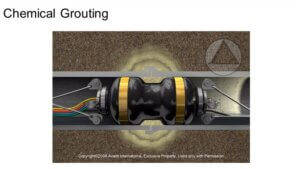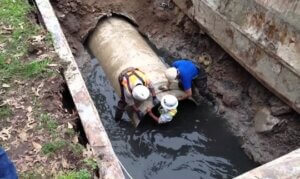Selecting Right-Sized & Cost-Effective Sewer Rehabilitation Methods
The drinking water and wastewater industry is facing challenges with aging infrastructure and increasingly strict compliance regulations. Municipalities across the nation are struggling with these issues and the financial burden associated with them. To maintain the sanitary sewer system infrastructure in the long term, rehabilitation is a highly cost-effective solution.
The components of sanitary sewer collection systems are prone to defects such as collapsed pipes, cracked pipes, offset joints, and cracked manholes. To reduce the cost and disruptions with excavation and replacement, more and more people are choosing sanitary sewer collection system rehabilitation.
Our expert, Wes Farrand, P.E., shares the details of the advantages and disadvantages of different rehabilitation methods. By determining which method is appropriate for extending the life of collection system assets, you can make informed decisions. Listen in to find out more.
Webinar Agenda
- Chemical Grouting (0:19)
- CIPP Lining (Sliplining) (3:33)
- Sliplining (11:05)
- Pipe Bursting (12:27)
- Additional Sewer Rehabilitation Techniques (13:23)
Chemical Grouting (0:19)

Chemical grouting is the injection of a gel-like substance into the pipe cracks and joints where it bonds with the soil to make a seal.
So what’s in the rehabilitation toolbox? There are quite a few things out there. The first one we’ll talk about is chemical grouting. Chemical grouting is the injection of a self-setting chemical gel-like substance, oftentimes into the joints or small walls and cracks. The grout will travel outside the pipe or manhole and into the surrounding soil and bond with the soil to create a seal or a collar around that leaking joint or wall defect. Here’s a graphic that shows how that works and how it injects that material into the joint sealing it off from infiltration & inflow. There are different materials that all do the same thing and they have different pros and cons to them. There’s a lot of control to this dependent on the different materials. The things they control are the amount of expansion, the setting time, whether it likes water or doesn’t like water, flexibility, shrinkage, strength, and stability. There are a lot of things that they can play within that chemical grout mix, and it has a service life of about 20 to 25 years.
Chemical Grouting Advantages (1:12)
- It is very effective at I&I reduction. That’s its focus, the direct cause of the I&I where it’s entering into the system.
- It’s effective against high-flow I&I, where you’ve got those runners and gushers. It can seal those off quite effectively.
- It stabilizes the surrounding soils, where you can lose some soil through those joints. This will stabilize that and hold that soil in place, and prevent the erosion of that soil.
- It does work well with other methods. This is an outside-the-pipe solution so that other rehabilitation methods can be done inside the pipe as well.
- It’s testable. They can do an air test to determine if a joint is leaky and if it needs to be sealed or if it’s been sealed properly.
- It can prevent small roots from coming into those joints. They do recommend a root inhibitor additive, but it can prevent those small roots and it’s a relatively low cost.
Chemical Grouting Disadvantages (2:02)
- It is not structural. If the pipe has structural issues, it’s not going to fix that. If soil or pipe movement occurs, it can compromise that seal.
- Offset joints or longitudinal cracks may not seal properly, and it’s difficult to use on pipes with rough surfaces. So it’s going to need a smooth surface pipe.
- If you’ve got a concrete pipe that has a lot of corrosion, it’s probably not going to work well.
- It’s not well suited for large voids. It’s going to fix the smaller cracks but not the large voids.
- It’s not going to be effective for large roots. They can work their way right through the chemical grout.
Chemical Grouting Applications (2:36)
Leak repairs are a good application for it. Here you can see where we’ve got water coming into the pipe through a joint. This is a good application for chemical grout. This is a pipe where the chemical grout was used, and you can see it’s worked its way into the joint and stopped off that seep there. It can be used in manholes around joint boot leaks where pipes are coming into the manhole. There are systems out there that can do this for several feet up lateral lines that can seal around where those laterals connect in to the mainline system.
Here’s an example of a leak that could be sealed with chemical grout and a lateral system and how those work. Another joint and crack would be an application. Chemical grout would work for that. This one here, chemical grout, is probably not going to work for this. It’s a lateral crack, and it’s a little bit big and too extensive. A small hole in the pipe? Chemical grout could work for that one. A large void in the side of a pipe? Chemical grout would not be recommended and would not be quite as effective on that. Gushing water in, infiltration runner? Yeah, it would work for that.
CIPP Pipe Lining (3:33)
The next one we’ve got is a CIPP lining. This is a common lining. People call this slip lining, but it’s called CIPP lining and requires zero excavation. All work is performed through manhole access. Here’s an example of how it looks going down into the hole. It is trenchless with very minimal impact. It has an epoxy resin-coated felt bag that is turned inside out of the pipe through pressure and steam. This is an example that shows how that turns inside out. Although this one has a problem in that you don’t want to do that with water in the bottom of your pipe because that can impact how well it works.
CIPP Lining Advantages
Its advantage is that it’s trenchless. It requires zero excavation. It’s all done from above the surface.
It is structural. It’ll provide structural repair to the host pipe. It can stand on its own, and the host pipe completely disappears around it. It’ll still work, and it stops further degradation or collapse of that host pipe.
It’s flexible. It can navigate through offset joints to a certain extent, around bends, missing sewer sections if the flow line is still there, and buried manholes even.
It does have moderate I&I reduction, although we always recommend, if that’s a real major issue, to consider maybe a chemical grout along with it.
And it has excellent root growth control because it’s a solid continuous pipe through the new pipe through the old pipe. It does help stop the roots at those joints. Although, where you reopen the taps, you can still get some root intrusion there, for the most part, it cuts out all the joint roots.
It does improve the flow coefficient of a lot of pipes, which can then help your capacity.
And it has a long service life.
CIPP disadvantages
Disadvantages?
High infiltration can wash out the resin. Like I mentioned in the other picture where there was water standing at the bottom of the pipe, that’s not recommended because it can wash out that resin and prevent the proper curing of that. Also, where you’ve got a runner, where water is actively pouring into a joint or a void, you’re going to want to fix that with maybe a chemical grouting before you do the lining because that’ll also wash out the resin.
Any sag or dip in the pipe is still going to be there because it’s going to follow the existing pipe’s path.
It can still allow some infiltration and inflow. There’s an annular space between the liner and the host pipe that water can travel along, and if you have a reopening where the sewer service is connected, water can get in there or at the manhole. It can be minimized with controlled curing, but there’s still a concern there.
It’s unable to line severe offsets or collapses.
It does result in a small reduction in pipe diameter. Although, usually, this is offset by the improvement to the smoothness of the pipe, so there’s not a major reduction in capacity.
Long reaches of large diameters are more difficult. They can be done, but large diameters become quite costly, whereas other applications or other rehabilitation methods can be more cost-effective.
CIPP Lining Applications
Applications for CIPP lining. Moderate to heavy structural defects or collapses. If the majority of the host pipe is still there, it can be lined through and can restore that pipe. Major collapses where the pipe is majorly damaged and obstructing the pipe that’s not going to work. Here’s another small offset. That would be fine. I like the operator’s note on this: “Not going to try.” The same thing for CIPP. You’re not going to be able to line through that. Something to consider with CIPP lining is where you have a protruding tap extending into the pipe. Those have to be removed. They can still line through that, but they’ll have to go in and grind that pipe off before they do that. Protrusions of pipe collapsed into the pipe. They’re not going to be able to grind that off to be able to get the liner, though, so that one’s probably not going to happen. It depends on the installer whether they would want to attempt that one or not.
Again, this is the same picture of that corroded concrete pipe. As long as the flow line is there at the bottom, they can line through that. But if that flow line is gone, they would not be able to line through that effectively. So that one you’re going to have to dig up, unfortunately. The idea is to catch them before they get that far. So, where we’ve got quarter-point cracking on this clay pipe on the left, that’s an ideal application for CIPP because it’s going to restore that pipe and eliminate any future movement of those cracked sections. If it’s already collapsing like that, most likely no. The roundness of the pipe is gone, and it’s going to be hard to restore. Again, a small I&I reduction where you just got a seep like this or a wet spot will be able to go through that.
But if you’ve got a runner, that’s going to wash the resin out of the pipe and you’re going to need to do something before. You can still line it, but you’re probably going to need to grout it or seal that leak before you do that CIPP lining. So at this point, you can see the I&I is coming through the service lateral. CIPP lining is not going to be able to address that because that service lateral has to be reopened and what they do is they run a cutter down the pipe and cut open those holes again. So as soon as they cut through that liner to reopen that service, that infiltration at the service connection is going to be re-established back to the pipe.
So, more than likely, you’re going to need to do some kind of chemical grouting with that as well. With infiltration coming into the pipe, you’re going to need to seal that off before CIPP will be effective. Root control. Here, you got lots of roots coming in at every joint. Lining through that is going to seal off every one of those joints, and that’s going to cut down on the root intrusion issues.
CIPP Lining Considerations
Some considerations for CIPP lining. We always recommend end seals at the manholes to help reduce some of that I&I traveling between the host pipe and the liner. There is some pre-lining work that needs to be done, like grinding protrusions and stopping heavy infiltration, so you might have some chemical grounding to go with that. Then, lateral services, something to consider is whether you’re going to reopen all of the lateral services or to spend the time and effort to identify which ones are still active and only open those because that limits the amount of I&I entry points into the system.
We had a case in a small town where the contractor that installed the pipe had an excess of performed Ys. And so, for about 100 ft. down the main street, it was nothing but Y sections in the sewer. So that was a location where we didn’t want to restore all those, so we just sealed them off with the lining work. And then lateral I&I, infiltration & inflow can come in from where the sewer service connects to the main. It can also come in further up into the sewer service itself, up into yards, and off of the mainline. Some things can be done for that, but there are some considerations there to think of, which ones do you do and who owns that line and different things like that.
Then, there are a couple of different curing methods out there that can be looked at. Steam versus chemical curing, there’s even ambient temperature curing. They have pros and cons. There’s even a UV-cured one, which is kind of a newer innovation and has less odor. Currently, it’s more expensive, but it is an option if the odor is a concern. Also, you need to know what you’re lining. If you’re lining through an industrial area, some chemicals can interfere with the curing of that resin. If there’s a school that has old boilers and the wastewater is hot, that can affect the curing of that system. So, you need to know where your system is and what kind of wastewater you have.
There’s a related method of using CIPP for just repairing a single point. This is maybe where the main is primarily good, but there’s a small spot where there’s some damage. So you can go in with maybe a 10-foot length intending to repair just an isolated issue. The resin that they use for this is usually more of a two-part epoxy that cures at ambient temperatures. Here’s an installation case where it was just one location so they put in a small section to line just that one spot. The cost-effectiveness of this is limited. However, our rule of thumb is if you’re going to have more than two-point repairs in a typical sewer section, you might as well just line the whole line. You get the benefit of the whole line because your costs are going to be about the same.
Sliplining Trenchless Pipe Rehabilitation (11:05)
Sliplining is another method. This is where a smaller pipe is inserted into an existing line and either pushed or pulled through that section. This can also be done with a spiral wound pipe. It does reduce the diameter of the pipe, so you can have some capacity issues. It’s not commonly used because it does require some excavation at the ends. So this is used more often where you have major concerns and where the excavation to put those pipes in doesn’t cause issues.
Sliplining Applications and Advantages
Applications and advantages. It does work best for large-diameter pipes. If you have a lot of service taps, this isn’t a good idea because you’re going to have to go in and reopen all those services. But if it’s a mainline where there are no service taps, maybe a trunk or interceptor, this can be an option. It also has limited access. Use in a place where this is going to be an advantage because you can push it through from one end and don’t have to access it along the way. It is a structural solution, so it’s, again, replacing the old pipe with a brand-new pipe.
Here’s an example graphic that illustrates how it’s done. There’s an excavation at one end, and there’s a liner, whether polyethylene or other materials, that gets pulled into the pipe to replace the old pipe.
Sliplining Disadvantages
Some disadvantages: it can only be done on straight runs. It’s not going to be able to wind around corners or bend very well. It does require an excavation for that insertion pit, and any service taps or laterals have to be reconnected with excavation as well.
Pipe Bursting (12:27)
Pipe bursting is another somewhat similar one. This involves breaking a pipe and inserting a new pipe inside of it. It can be equal to or greater in diameter. It pulls a mandrill through first, which breaks the old pipe, and then that mandrill pulls in the new pipe behind it, so it’s a simultaneous installation.
Pipe Bursting Advantages
Advantages? It is structural. You’re bringing in a whole new pipe. Best in places where there are few service taps, again like slip lining or where you have limited access. If your pipe diameter is critical for capacity reasons, this can be a way to get in a pipe diameter that’s similar to or larger than the other one to improve capacity or at least maintain it.
Pipe Bursting Disadvantages
Disadvantages?
It does also require an insertion and an extraction pit excavation. So you need to have access and be able to dig up at either end.
Any service taps or laterals do have to be excavated and reconnected.
There are limited pipe materials that you’re able to burst. You’re not going to be able to do it to steel or cast iron, but clay can burst.
Additional Sewer Rehabilitation Techniques (13:23)
Centrifugally Cast Mortar Lining
Another method is a centrifugally cast mortar lining. This is typically used for large-diameter pipes. It is structural. It casts a concrete mortar material, spun through that machine in the middle there, and spun onto the outside of the pipe, low slump sticks, and builds up. You can get depths of 1 1/2 in. or more. However, it is subject to corrosion because it is a concrete material. So, if sulfide corrosion is an issue, this isn’t a good application. Other cementitious coatings can be used in manholes. These can be troweled on or sprayed on to line old manholes. This one’s lining an old brick manhole, so it’s providing some structural stability to that brick before it degrades over time.
Polymer Coatings for Manholes
Some polymer coatings are used for manholes and a lot of different chemical options. These can be corrosion-resistant. Something to think about on these, though, is surface prep is critical. It’s important to get all the old and any degraded material or loose material off of the old pipes or structures to have this adhere and cure. Other ones that are out there are fold & form, pipe eating, and spiral wound slip lining. There are several out there that aren’t as common, but there are other options if there are special considerations.
Less Common Sewer Rehabilitation Methods
Some other considerations as we wrap up here. Trenchless methods are cost-effective when compared to dig and replace. They’re almost always less expensive and can provide a similar service life. There are some service interruption thoughts to think about. Where you have critical businesses like hairdressers, carwashers, schools, nursing homes, and hospitals, these systems will interrupt services. So there are some considerations there to think about maybe using some night work. Innovations, everyone’s always trying to build a better mousetrap. Some work, and some don’t. The disadvantages of one method could be resolved and become less of an issue in the future.
Another thing to think about, we worry about infiltration and inflow, but we’ve had issues in the past with exfiltration and exflow, which is interesting. Where I&I was the issue, and we lined a community. They couldn’t do the whole community, but they did a vast majority of their system, mostly at the downstream end, and what they found is that the flows in their plant went up. We thought the plan was to get rid of the I&I, and what we realized was where water can come in, water can also go out. The downstream area had a lot of sandy soils, and so they were losing a lot of their wastewater out into the surrounding soil as well. when we sealed that up, it increased the flows of the plant by just keeping the water that was in the pipe in the pipe.
So, something to think about and consider when looking to address I&I is to make sure that all those potentially unintended consequences are addressed.
So, hopefully, this has been informative and maybe helpful to you as you look to manage your sewer systems. You’re never going to be able to catch them all, but the idea is to be proactive and address as many as you can that hopefully reduce the incidences of potential failures and problems down the road. Setting those priorities and accurately evaluating those existing conditions, and then a proper selection of the appropriate rehabilitation method is key to a successful sewer maintenance program. Thank you.

Wes Farrand, P.E.
Civil EngineerWes Farrand, P.E.
Civil EngineerCombined Sewer Planning & Design, Hydrologic & Hydraulic Analysis, Water Main design

